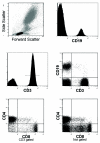Medical applications of leukocyte surface molecules--the CD molecules
- PMID: 17380197
- PMCID: PMC1829200
- DOI: 10.2119/2006–00081.Zola
Medical applications of leukocyte surface molecules--the CD molecules
Abstract
Leukocytes are the cells of the immune system and are centrally involved in defense against infection, in autoimmune disease, allergy, inflammation, and in organ graft rejection. Lymphomas and leukemias are malignancies of leukocytes, and the immune system is almost certainly involved in most other cancers. Each leukocyte expresses a selection of cell surface glycoproteins and glycolipids which mediate its interaction with antigen, with other components of the immune system, and with other tissues. It is therefore not surprising that the leukocyte surface molecules (CD molecules) have provided targets for diagnosis and therapy. Among the "celebrities" are CD20, a target for lymphoma therapeutic antibodies which earns $2 billion annually (and makes a significant difference to lymphoma patients), and CD4, the molecule used by the human immunodeficiency virus (HIV) as an entry portal into cells of the immune system. This short review provides a background to the CD molecules and antibodies against them, and summarizes research, diagnostic, and therapeutic applications of antibodies against these molecules.
Figures

References
-
- Mak TW, Saunders ME. (2006) The immune response: basic and clinical principles. Elsevier/Academic Press, Amsterdam.
-
- Bernard AR, Boumsell L, Dausset J, Milstein C, Schlossmann SF, eds. (1984) Leucocyte typing: human leucocyte differentiation antigens detected by monoclonal antibodies. Springer, Berlin.
-
- Reinherz EL, Haynes BF, Nadler L, Bernstein ID, eds. (1985) Leukocyte typing II. Springer, New York.
-
- McMichael AJ, Beverley PCL, Cobbold S et al., eds. (1987) Leucocyte typing III: white cell differentiation antigens. Oxford University Press, Oxford.
-
- Knapp W, Dorken B, Gilks W, Rieber EP, Schmidt RE, Stein H, von dem Borne AEGK, eds. (1989) Leucocyte typing IV: white cell differentiation antigens. Oxford University Press, Oxford.
Publication types
MeSH terms
Substances
LinkOut - more resources
Full Text Sources
Research Materials
